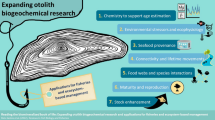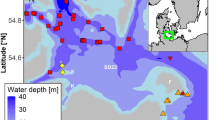Abstract
Bromine was found to accumulate in otoliths of Norwegian coastal Cod Gadus morhua that were reared under known conditions. Despite the fact that the Cod were moved from one rearing environment to another, causing marked changes in some otolith elemental concentrations, bromine appeared to accumulate continuously along certain growth axes as revealed by 2-D elemental mapping. In contrast, North Sea and Baltic Sea Cod showed little to no patterning in Br. We suggest that Br uptake in otoliths may be under physiological and genetic control, and as such, may prove useful as a stock identification tool.



Similar content being viewed by others
References
Bilderback DH, Huang R, Kazimirov A, Kriksunov IA, Limburg K, Fontes E (2003) Monocapillary optics developments and applications. Adv X-ray Anal 46:320–325
Campana SE (1999) Chemistry and composition of fish otoliths: pathways, mechanisms and applications. Mar Ecol Prog Ser 188:263–297
Cornaby SW (2008) The handbook of x-ray single-bounce monocapillary optics, including optical design and synchrotron applications. Thesis (Ph. D.)—Cornell University, Ithaca, NY
Dale DS (2009) XPaXS library of computational routines for X-ray science. Available online: http://www.chess.cornell.edu/software/xpaxs/
ESRI (2009) ArcGIS, Version 9.3. ESRI, Redlands, CA
Høie H, Andersson C, Folkvord A, Karlsen Ø (2004) Precision and accuracy of stable isotope signals in otoliths of pen reared Cod (Gadus morhua L.) when sampled with high resolution micromill. Mar Biol 144:1039–1049
Limburg KE, Elfman M (2010) Magnitude and patterns of Zn in otoliths support the recent phylogenetic typology of Salmoniformes and their sister groups. Can J Fish Aquat Sci 67:597–604
Limburg KE, Huang R, Bilderback DH (2007) Fish otolith trace element maps: new approaches with synchrotron microbeam X-ray fluorescence. X-Ray Spectrom 36:336–342
Olson C, Limburg K, Patterson W, Elfman M, Kristiansson P, Ehrenberg S (2002) Reconstruction of fisheries and environment from the Stone Age: preliminary studies of hard parts of Codfish (Gadus morhua) from Ajvide, Gotland, Sweden. Remote Sens II:375–385
Pingitore NE, Cruz-Jimenez G, Wellington GM (2002) Bromine in scleractinian coral aragonite: X-ray absorption spectroscopy. American Geophysical Union, Spring Meeting 2002, abstract #B31A-09
Proctor CH, Thresher RE (1998) Effects of specimen handling and otolith preparation on concentration of elements in fish otoliths. Mar Biol 131:681–694
Solé VA, Papillon E, Cotte M, Walter PH, Susini J (2007) A multiplatform Code for the analysis of energy-dispersive X-ray fluorescence spectra. Spectrochim Acta Part B 62:63–68
StatSoft, Inc (2003) STATISTICA (data analysis software system), version 6. www.statsoft.com
Svedäng H, André C, Jonsson P, Elfman M, Limburg KE (2010) Migratory behaviour and otolith chemistry suggest fine-scale sub-population structure within a genetically homogenous Atlantic Cod population. Env Biol Fishes. doi:10.1007/s10641-010-9669-y
Townsend DW, Radtke RL, Malone DP, Wallinga JP (1995) Use of otolith strontium: calcium ratios for hindcasting larval cod Gadus morhua distributions relative to water masses on Georges Bank. Mar Ecol Prog Ser 119:37–44
Wolf RE, Wilson SA (2007) USGS reference materials program: serving the needs of the global analytical community. US Geological Survey Fact Sheet 2007-3056
Acknowledgments
We thank Y. Walther and H. Svedäng, Swedish Fisheries Board, for providing otoliths of Cod from the Baltic and North seas, respectively, and Ø. Karlsen, Institute of Marine Research Norway, for the Norwegian coastal Cod otoliths. We also thank S. Cornaby for producing the glass capillaries used in the analysis. Finally, we thank two anonymous reviewers for constructive criticism of an earlier draft. This work is based upon research conducted at the Cornell High Energy Synchrotron Source (CHESS) which is supported by the National Science Foundation and the National Institutes of Health/National Institute of General Medical Sciences under NSF award DMR-0225180. Partial support (to KL) was from NSF grant DEB-0238121.
Author information
Authors and Affiliations
Corresponding author
Rights and permissions
About this article
Cite this article
Limburg, K.E., Høie, H. & Dale, D.S. Bromine patterns in Norwegian coastal Cod otoliths—a possible marker for distinguishing stocks?. Environ Biol Fish 89, 427–432 (2010). https://doi.org/10.1007/s10641-010-9660-7
Received:
Accepted:
Published:
Issue Date:
DOI: https://doi.org/10.1007/s10641-010-9660-7




